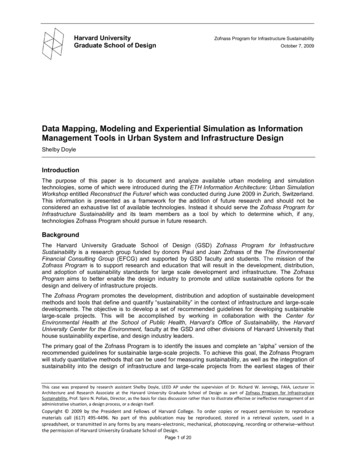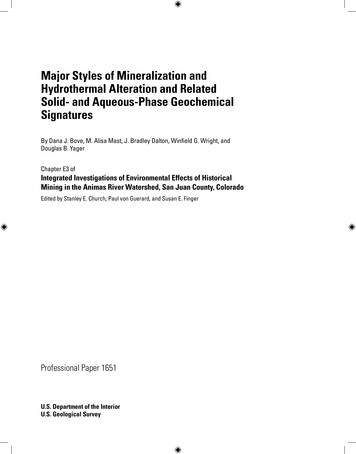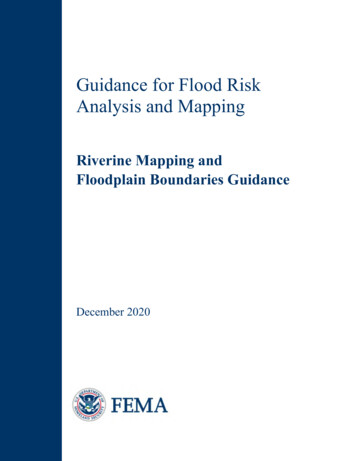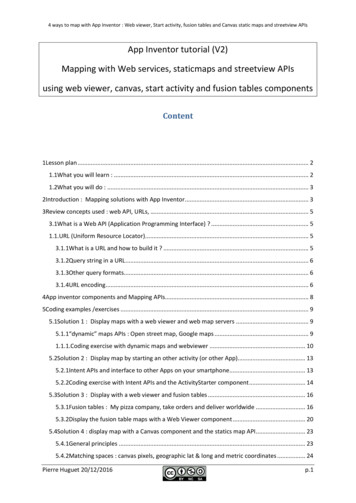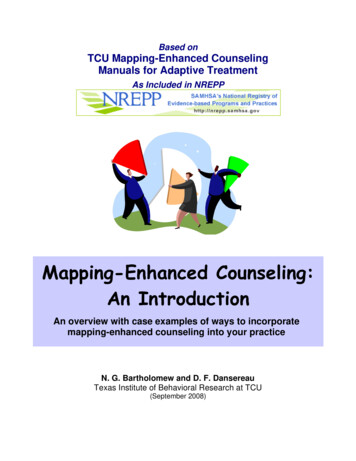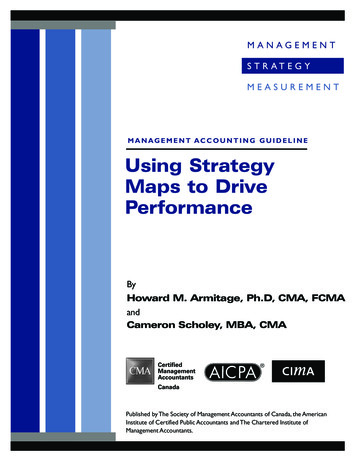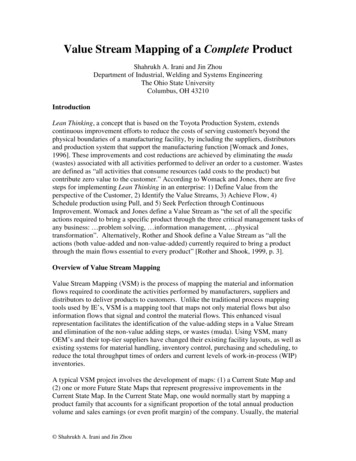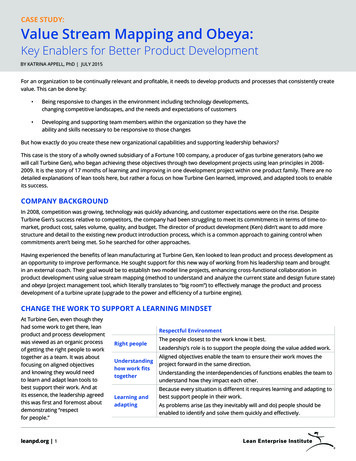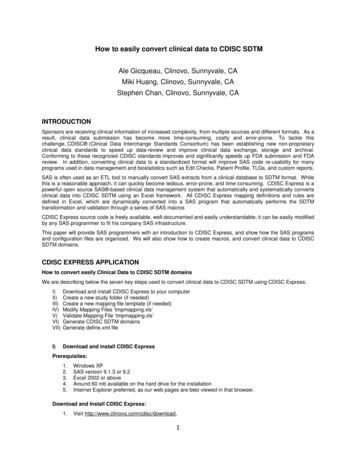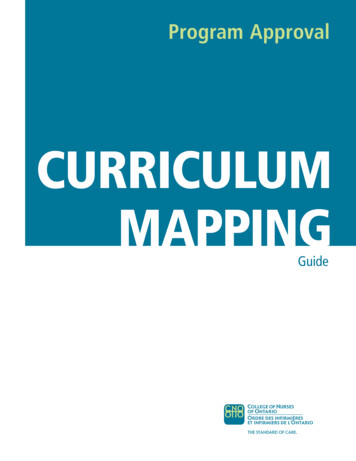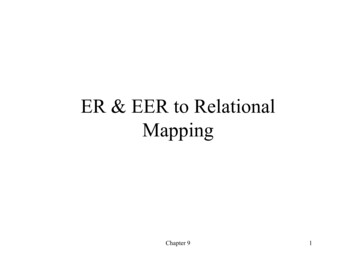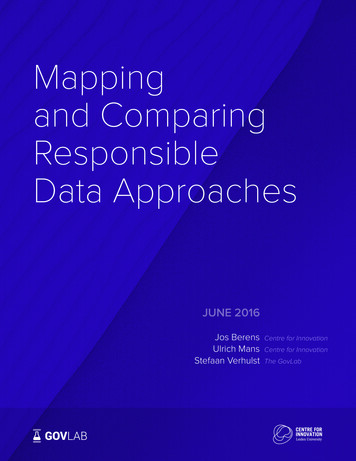
Transcription
Mappingand ComparingResponsibleData ApproachesJUNE 2016Jos BerensUlrich MansStefaan VerhulstCentre for InnovationCentre for InnovationThe GovLab1
TABLE OF CONTENTSA. The need for mapping and comparing responsible data approaches . . . . . . . . . . . . . . . . . . . 3B. Methodology . . . . . . . . . . . . . . . . . . . . . . . . . . . . . . . . . . . . . . . . . . . . . . . . . . . . . . . . . . . . . . . . . . . 5B.1. Included Data Responsibility Approaches. . . . . . . . . . . . . . . . . . . . . . . . . . . . . . . . . . . . . . . . . . . 5B.3. Generic insights gained from the peer review. . . . . . . . . . . . . . . . . . . . . . . . . . . . . . . . . . . . . . . 7C. Comparative analysis and findings. . . . . . . . . . . . . . . . . . . . . . . . . . . . . . . . . . . . . . . . . . . . . . . . 10C.1. Scope of the Policy . . . . . . . . . . . . . . . . . . . . . . . . . . . . . . . . . . . . . . . . . . . . . . . . . . . . . . . . . . . . . 10C.2. Value-Proposition. . . . . . . . . . . . . . . . . . . . . . . . . . . . . . . . . . . . . . . . . . . . . . . . . . . . . . . . . . . . . . 12C.3. Data. . . . . . . . . . . . . . . . . . . . . . . . . . . . . . . . . . . . . . . . . . . . . . . . . . . . . . . . . . . . . . . . . . . . . . . . . . . 14C.4. Risk-Assessment. . . . . . . . . . . . . . . . . . . . . . . . . . . . . . . . . . . . . . . . . . . . . . . . . . . . . . . . . . . . . . . 16C.5 Value-Chain. . . . . . . . . . . . . . . . . . . . . . . . . . . . . . . . . . . . . . . . . . . . . . . . . . . . . . . . . . . . . . . . . . . 22C.6. Principles and Legal Foundation. . . . . . . . . . . . . . . . . . . . . . . . . . . . . . . . . . . . . . . . . . . . . . . . . 23C.7. Tools and Practices. . . . . . . . . . . . . . . . . . . . . . . . . . . . . . . . . . . . . . . . . . . . . . . . . . . . . . . . . . . . . 24C.8. Accountability and Design . . . . . . . . . . . . . . . . . . . . . . . . . . . . . . . . . . . . . . . . . . . . . . . . . . . . . . 25D. Takeaways . . . . . . . . . . . . . . . . . . . . . . . . . . . . . . . . . . . . . . . . . . . . . . . . . . . . . . . . . . . . . . . . . . . . 28Appendix 1. Repository of Documents Reviewed. . . . . . . . . . . . . . . . . . . . . . . . . . . . . . . . . . . . . . 31Appendix 2. Comparative Table. . . . . . . . . . . . . . . . . . . . . . . . . . . . . . . . . . . . . . . . . . . . . . . . . . . . . 352
Mapping and Comparing1Responsible Data ApproachesJOS BERENS, ULRICH MANS AND STEFAAN VERHULST2A. The need for mapping and comparingresponsible data approachesWe are witnessing a growing awareness of the potential offered by data in the humanitarian space.Data, and more generally information, can offer insights into fast-moving situations, helping humanitarianorganizations, policymakers and others identify emerging crises, track their spread or evolution, andrespond in more targeted and effective ways. At the same time, the exponential increase in the amountof available data—and in the sources of data—adds a new level of complexity. As much as data offersnew opportunities, it also poses new risks—risks that are magnified given the vulnerability of affectedstakeholders. It is therefore essential to ensure that any use of data in humanitarian contexts is governedthrough a balanced and well-articulated set of data policies and guidelines. In order to realize thepotential of data while minimizing its harms, we need a framework for data responsibility.Such a framework is key to ensuring a fair and equitable approach to the use of data. Perhaps mostimportantly, it is essential to ensuring equity in the on-the-ground impact of policy decisions and actions thatrely on data. Inadequate or irresponsible handling of data does not only pose the risk of ineffectiveness;it can also negatively impact “data subjects,” threatening further harms to the very populations that data1 The comparative analysis was commissioned by United Nations Office for the Coordination of Humanitarian Affairs (UNOCHA) to inform thedevelopment of data policies at UNOCHA and engage the broader humanitarian community on data responsibility. The analysis and subsequentopinions and recommendations expressed in the paper are the authors’ own and do not reflect the view of UNOCHA.2 We are grateful to Melissa Amoros-Lark and Nicolas Castellon (Student Fellows at Leiden University’s Centre for Innovation) for their researchassistance. We also benefitted tremendously from Sarah Telford’s input and leadership at UNOCHA3
is supposed to serve. Therefore, in order to create adequate level of trust and ensure the effectivenessof data-driven innovations across the humanitarian sector, data policies, guidelines and implementationsafeguards need to be developed and rigorously tested. An ability to measure (and, if necessary, adjust)the outcome of actions is also essential: it must be clear how to close loopholes and correct unsuccessfulpractices in order to hold governing agencies and others accountable.The need for a responsible data governance approach has now been recognized by a wide variety oforganizations, both within and outside the humanitarian space.3 In addition, there are various technologyoriented organizations that operate in related fields and that are also working on in developing theirresponsible data approach, humanitarian organizations should be guided both by the themes found inother data policies and guidelines, and by other documents that determine how they should conducttheir work (such as the humanitarian principles) that have started considering responsible data use or thatseek to revise existing policies to adapt to the increasingly fast-paced data landscape.4The goal of this paper is to examine some of these existing approaches and, based on a comparativeanalysis, to identify best practices and innovative approaches to governing data in humanitarian contexts.To that end, Leiden University’s Centre for Innovation and the Governance Laboratory at New YorkUniversity (The GovLab) have together undertaken a mapping exercise of 17 existing responsible dataapproaches. The list of organizations studied and links to their data responsibility approaches can befound in Appendix 1: it includes 7 UN agencies, 7 International Organizations, 2 government agencies and1 research institute.5 The results of our comparative exercise are presented in Section C, which presentsan analysis organized along eight key themes. Section D includes six takeaways or best principles.Taken together, these can serve as a toolkit for any organizations—particularly those operating in thehumanitarian space—seeking to use data more responsibly and effectively.The GovLab and the Centre for Innovation are partners in a broader collaboration on the topic of dataresponsibility, together with Data-Pop Alliance, the Data & Society Research Institute and UN Global Pulse- the International Data Responsibility Group. The IDRG is a global network of experts and organizationsworking on the principles and standards that are required for guiding the Data Revolution in the contextof humanitarian action, sustainable development and peace & justice. Its members seek to build anauthoritative knowledge platform that enables responsible experimentation on the release, processingand use of data and minimising risks. The IDRG is designed as a networked platform, with a coordinatingsecretariat in The Hague, The Netherlands.3 See for example the Resolution adopted during the 37th International Conference of Data Protection and Privacy Commissioners, to befound at: ction.pdf4 Examples include the United Nations Global Pulse team (Privacy Impact Assessment), World Food Programme and International Organization for Migration.5 Repository includes documents by: EU Regulation, GSM Association, IOM, LIRNEasia, Médecins Sans Frontières, Principles for DigitalDevelopment, Oxfam, UN Global Pulse, UNHCR, UNICEF, the Humanitarian Principles, HDX’s policy, UN Office for Outer Space Affairs, UnitedNations Population Fund, USAID, ICRC and the White House Precision Medicine Initiative.4
B. MethodologyAs noted, this paper contains a comparative analysis of 17 responsible data approaches–includingdata policies, principles and regulations (see summarized list in B.1). These approaches were selectedto reflect developments in data responsibility in international organizations of various sizes and withdifferent missions. They add up to something of a map of existing efforts that can help lay the foundationsfor our efforts to develop a set of best practices that can guide other organizations in their efforts to usedata more responsibly and effectively.The 17 approaches selected are not meant to provide a comprehensive overview of all existingapproaches, yet were selected because each represents a particular model, approach or set of principlesthat if taken together could enable the development of a meaningful data policy. In addition, severalapproaches are of immediate relevance to the humanitarian field while others are considered landmarkdocuments that provide a foundation to build upon.In analyzing the respective approaches, we use the template outlined in B.2. This template, which hasbeen jointly developed by The GovLab and Leiden includes the key components of a responsible datagovernance framework, and provides a full matrix of analysis to identify best practices.B.1. INCLUDED DATA RESPONSIBILITY APPROACHESMédecins Sans FrontièresData Sharing Policy2013OxfamResponsible Program Data Policy2015UN Population FundInformation Disclosure Policyn.d.UNOCHAHumanitarian Data Exchange Terms of Servicen.d.UNHCRPolicy on the protection of Personal Data of Personsof Concern to UNHCR2015LIRNEasiaDraft Guidelines for Third-Party Use of Big Data2014Generated by Mobile Network OperatorsGSMAGuidelines on the protection of privacy in the useof mobile phone data for responding to the Ebolaoutbreak2014White HousePrecision Medicine Initiative; Privacy and TrustPrinciples2015UN Global PulsePrivacy and Data Protection Principles20155
UN Office for Outer Space AffairsInternational Charter for Space & Major DisastersUNOCHAHumanitarian PrinciplesDigital Impact AlliancePrinciples for Digital DevelopmentEuropean UnionDraft General Data Protection Regulation2012International Organization for MigrationData Protection Policy2010UNICEFInformation Disclosure Policy2011USAID ADS Chapter 508Privacy Program201420001991, 2004International Committee of the Red Cross Rules on Personal Data Protectionn.d.2016B.2. TEMPLATE OF ANALYSISBased on previous research undertaken inside and outside this field, and based on a preliminaryassessment of both the selected data responsibility approaches and additional ones, GovLab and Centrefor Innovation distilled the key elements of a well-balanced and comprehensive data responsibilityapproach. Based on these essentials, GovLab and Leiden developed the following template for analysis:SCOPE OF THE POLICYDoes the policy clarify its goals and objectives? ( For example, does it clearly state objectives such as ‘dataprotection’, ‘data subject safety’, ‘organisational integrity’, ‘infrastructural security’ and others)Does the policy describe the context in which data is collected, used and shared (clarifying, for example, datatypes, origin and processing method)?VALUE-PROPOSITIONDoes the policy indicate the expected value or benefit of the protection, use and analysis of the data-set(s)? And if so, how?Does the policy include suggestions on how the impact and value of the data will be measured? And if so, how?DATADoes the policy describe the (technical specifications – i.e. the type of files, the size, and other characteristics of)data-set(s) it oversees and if so how?Does the policy include an audit or process to determine what data is necessary for the purpose and anticipated value?RISK-ASSESSMENTDoes the policy indicate or establish a process to determine the risk that the analysis and/or use of the data maygenerate, either to the organization, its beneficiaries or others?Does the policy describe or list risk mitigation strategies to mitigate or respond to the risk? If so, which ones are listed?6
VALUE-CHAINDoes the policy describe the value-chain of data and the benefit/risks at each stage?How is the data processed?PRINCIPLES and LEGAL FOUNDATIONAre the principles (and or ethical norms) explained that guide the policy?Is the legal basis upon which the policies and principles build explained? And what is that basis?TOOLS AND PRACTICESWhat tools and practices are specified to implement the principles and policies?What decisions do those tools and practices inform?ACCOUNTABILITY and DESIGNDoes the policy explain how it was created?Is it based upon either participatory or user design principles?What monitoring and evaluation mechanisms are implemented by this data strategy?Are there dispute resolution mechanisms?Does the policy explain any roles and functions that are tasked with the implementation of the policy?The selected data responsibility approaches were analyzed according to the above template, and werechecked for their inclusion of the themes. A quantitative comparison revealed the prevalence of themesin the selection of approaches. Subsequently, qualitative analysis was directed particularly towardsunexpected outliers in the quantitative comparison.B.3. GENERIC INSIGHTS GAINED FROM THE PEER REVIEWThe authors of this paper are thankful for the insights and feedback from our review group. We receivedand integrated comments from the ICRC, IOM, LIRNEasia, UN Global Pulse, UNHCR, UNICEF and USAID.All reviewers acknowledged the need to develop a data governance framework, and provided severalcomments and insights on our effort that have proven invaluable in taking this project forward. Weintegrated all their review, yet some reviewers provided some important top-level reflections, including:“The document that has been distributed for comment seeks to impose the Europeanapproach on emerging ‘big data’ practices, ignoring the alternative approaches and indeedstripping away essential elements of the context-specific guidelines adopted in several ofthe documents covered by the interim findings ( )”7
“We are in the process of discovering the potential of big data for humanitarian purposes.Overly prescriptive and rigid frameworks derived from entirely different circumstances (useand abuses of information pertaining to creditworthiness) to an inchoate field of investigationhas the potential to stifle discoveries. To minimize harm, it is advisable to be minimalistic indevising regulatory schemes.”“There don’t seem to be any reflections within existing policies on the particular challengesassociated with merging of databases or interoperability. The assumption seems to bethat most data sources are singular but the merging of datasets provides both the greatestchallenges to privacy as well as the greatest opportunities.”“( ) the term ‘responsible data approaches’ is a very generic term which hides a lot of variationand nuances. In fact governance mechanisms within a specific institution may differ hugelydepending upon whether the data is big/open; actively or passively collected; generated in anonline or offline environment as well as the local context where the data was collected e.g ‘rightto be forgotten principle’ is not universal. It might be useful for the authors to reflect on the needfor greater disaggregation and categorization within a broad data governance mechanism.”“It would be interesting to reflect on how many of the policies focus more on data collection andsharing rather than longer term management, updating and storage. This includes the need forongoing consent or an acknowledgement that this may be required which I think is generally poorlyreflected. I think there is also a general absence of references in policies to virtual data storage.”‘Responsible’, ‘data’ and ‘approach’ are all very broad terms, causing the risk of a toogeneric and high-level comparison.“This is not only about ethics. There is (also) law. ( ) based on the 1990 UN GA Guidelinesand Human Rights Law which even IGOs cannot entirely ignore where their activities havean impact on individuals ( ), there is a ‘residual’ body of law that they should respect whendealing with personal data.”“On Innovative approaches and the consideration of behavioral or economics approachesto inform particular choices or behaviors. This is definitely interesting but should probably benotes as complementary to regulatory approaches. May need a combination of ‘carrots’ and‘sticks’ when systemic institutional change is required.”“(.) an issue we have heard repeatedly from development actors is lack of clarity aboutwhere the policy sits within the organization in terms who is ultimately accountable forimplementation of the policy and to revisit the policy if needed.”8
“Change in organizational mindset is also a big challenge when developing such policies [Need] to be mindful of this and ensure that organizational needs are clear upfront andstakeholders see the benefit of such a policy to their work, particularly, in humanitariancontexts where it could be seen as administratively burdensome in conflict situations.”International organisations developing their data strategy cannot choose between a highlevel approach or implementation documents if they are not subject to domestic law, and willneed both a policy and mechanisms for implementation.SOME RESPONSES TO THESE COMMENTSThis work intentionally took a broad approach in including relevant documents for analysis. We felt itimportant to be able to provide a template of analysis that could be made operational for humanitarianorganizations seeking to draft a data policy. Seeking out recurring themes instead of similar clausesor phrases allowed the team to include principles, guidelines and policies. Keeping in mind the rapiddevelopment of the field of humanitarian data use, these meta-results leave ample room to determine themost feasible, workable and practical modality for implementation. Further, such a broad approach providesa sense not only of the themes to be covered, but also the different types of modalities to address them.Second, we didn’t aim to be fully comprehensive of all the data policies that exist yet we curatedapproaches that could provide lessons, practices and language relevant for humanitarian organizations.Based on this curated approach, the authors aimed to capture an initial base of lessons learned, whichwas reviewed and improved through a participatory process. In the review process, several additionaldocuments and initiatives were suggested for inclusion, among which the 1990 UN Guidelines for theRegulation of Computerized Personal Data Files and the ‘Data Protection and Humanitarian Action’project by The Brussels Privacy Hub at the Vrije Universiteit Brussels (VUB) and the InternationalCommittee of the Red Cross (ICRC). The authors will take these resources into account for any futurefollow-up to this work.Finally, this work is not a legal analysis, although the applicable legal context in which a policy is createdand operationalized should always be taken into account. Given that many humanitarian organizationswork across borders, they may need to comply with varying local legal regimes or different localimplementations of international data protection law.9
C. Comparative analysis and findingsIn what follows, we compare the 17 documents along eight themes. These eight themes constitute whatwe believe to be the key elements of a responsible data use framework. They are designed to be broadenough to be broadly applicable, yet specific enough to be operational and actually usable.C.1. SCOPE OF THE POLICYDetermining the scope of a data policy–i.e. to which data, which use and which actors the policy applies–is important for data users to determine whether the policy applies to them, and how; and for partnerorganisations in assessing how their data may be handled if they share it. It also provides an opportunityto share the rationales, goals and priorities behind the policy.C.1.1. CLARIFICATION OF GOALS AND OBJECTIVESAll of the reviewed data policies include a section that explains the overall goal of the document. There isa broad variety in the way goals are stated, ranging from very concrete user cases to generic principles. The Global System for Mobile Communication Association (GSMA) guidelines, for example, weredeveloped for mobile data sharing efforts aimed at fighting the Ebola epidemic, While MSF emphasizes the organization’s wish to ensure the highest standards in monitoring and documentation. The International Organization for Migration (IOM) data protection manual features the most detailedlist of goals (“key objectives”), including data-specific aspects (among others integrity, confidentiality, data protection) as well as; organizational aspects (among others institutional safeguards, enhance understanding). Other data policies showed forward-looking benefits such as preparing for the rising use of data(e.g. Oxfam’s data policy states it is preparing the organization for the future) and to build trust in theonline environment as to aid the digital economy (e.g. EU General Protection Data Regulation).In general, we identified two types of goals: Those related to the impact on the use of data that the policy aims to facilitate, such as the use of data formonitoring and documenting interventions to improve services (see also value proposition below),6 and;6 See for example the Medicins Sans Frontieres Data Sharing Policy, in which MSF states that they “place a high value on monitoring anddocumenting MSF medical interventions in order to continually improve the quality of care delivered.”10
Those goals that relate to the responsible use of data as a means of protecting data subjects andtheir rights,7 preventing liability, risk and harm.8 Clearly stating the intent of both data use in the firstplace, accompanied by a description of the aims of the policy document, significantly aids in theinterpretation of the provisions that follow.IOM’s policy takes account of these two goals and encapsulates it into its definition of data protection:“Data protection is the systematic application of a set of institutional, technical and physical safeguardsthat preserve the right to privacy with the respect to the collection, storage, use, and disclosure ofpersonal data.”C.1.2. DESCRIPTION OF CONTEXTMore than half of data policies analyzed provided detailed descriptions of the context in which their data iscollected and used. The descriptions vary depending on the mandate of the institution as it is apparent thatorganizations with a technical mandate are more exact with their definitions. There are three categories ofdocuments when it comes to referencing data types (see section 3.1. for technical specifications): One category states a specific data type (for example, data on refugees in the case of the UN Officeof the High Commissioner for Refugees (UNHCR), humanitarian data in the case of UN-OCHA’sHumanitarian Data Exchange (HDX) and mobile data in the case of the GSMA). Other institutions cast wider definitions that address the field the data concerns, such as PrecisionMedicine Initiative stating it concerns medical data, and IOM stating it deals with all types of personaldata relating to their beneficiaries. This second category often refers to any data that is relevant in thegiven context (e.g. “all data used by EU citizens” in the European Data Protection Regulation (EDPR)document and “all information in the possession of the UNFPA [United Nations Populations Fund, ed.]”). A third category does not mention the type of data that is covered (e.g. digitalprinciples.organd Oxfam). In the latter category, one can also include the International Charter: Space andDisasters, which includes a broad definition without using the term data: “critical information for theanticipation and management of potential crises”.7 See for example IOM, which states that “The collection and processing of personal data are necessary components of IOM’s commitment tofacilitate migration movements, understand migration challenges, and respect the dignity and well-being of migrants. IOM’s data protection strategyseeks to protect the interests of IOM’s beneficiaries, as well as the Organization [ ] [i]t recognizes both the rights of individuals to protect their personaldata and the need of IOM to collect, use and disclose personal data in the course of fulfilling its migration mandate” – see IOM Data Policy, p.9 and 13.8 See for example UNHCR, which states that “[i]ts purpose is to ensure that UNHCR processes personal data in a way that is consistentwith the 1990 United Nations General Assembly’s Guidelines for the Regulation of Computerized Personal Data Files and other internationalinstruments concerning the protection of personal data and individuals’ privacy.”11
C.2. VALUE-PROPOSITIONA description of the purpose and the anticipated benefits of using data is essential for both datasubjects, data users, partner organisations and the general public, to understand the benefit/riskbalance that an organisation aims to strike through its data policy. When accompanied with concretemetrics and indicators, an expression of the value one hopes to create also allows for subsequentimpact assessment–enabling more evidence based policy making.C.2.1. VALUE PROPOSITION DESCRIPTIONOver half of the data policies reviewed indicate the expected value or benefit of the use and analysis ofthe data. Benefits were listed in a wide variety of ways such as for: improving research (e.g. MSF: “MSF’s large repository of Research data together with routinelycollected data can potentially be of value to researchers working in public health.”); creating public trust in the work of the organisation through information sharing (UNICEF); modelling and planning efforts (GSMA Guidelines for responding to the Ebola outbreak); The ICRC lists the following concrete purposes in article 3 of its principles section: restoring family links protecting individuals in detention protecting the civilian population building respect for IHL – including through training and capacity building; providing medical assistance forensic activities weapon decontamination ensuring economic security protecting water and sanitation system preventive and curative health care. LIRNEasia remains more general in its value proposition statement, noting in the introduction that “BigData has an immense, and at this point unique, potential to bring forth a qualitative transformationof urban design including resilience, improve transportation and government-service delivery, andenhance management of the economy, among others.”12
A general statement of the value proposition of data use is included in the Precision Medicine InitiativePrinciples, i.e. to enable “a new era of clinical care” without further detail.9 The IOM Policy contains a fullsection on the need for a clear value proposition for data use.10 This includes a mechanism to determinewhether the value proposition of additional (unforeseen) use of the data is compatible with the originalpurpose of use,11 and ‘Compatible Research’ on the data, through i.e. ‘data matching’: “(.) the electroniccomparison of two or more sets of personal data that have been collected for different specifiedpurposes.”12 Accordingly, assessing the value of the data is also linked to retention and accuracy of the datawhich may have an impact on service delivery.C.2.2. DATA IMPACT MEASUREMENTOur analysis indicates that there is a clear lack of inclusion of value and impact indicators in data policies.Hardly any data policy included suggestions on how the impact and value of the data would be measured,and what indicators may be used to determine success. The “Principles for Digital Development”, developedby a collective of international NGOs, UN agencies and donors, mentions the need to design projects sothat impact can be measured with discrete milestones to focus on outcomes, yet most fail to do so. TheIOM policy states that “due to the multifaceted nature of IOM’s activities, data protection issues need tobe considered at all stages, from project development and implementation to evaluation and reporting”.Yet indicators are not included, instead, this is presumably left to the indicators in the different projectscovering the various IOM activities.Making value and impact indicators explicit allows data users to determine how their data benefits theorganisation in a given context. It also allows for more rigorous project evaluation, which will inform thedevelopment of subsequent data-driven engagements.When developing a data governance framework, including indicators is a useful instrument to helpdetermine whether data use is justifiable based on the intended deliverables, especially when sensitivedata is accessed in crisis situations. Fast decision making requires clear and concise prescriptions todetermine whether to move forward or to halt a given project.9 In the Precision Medicine Initiative Privacy and Trust Principles: “Precision medicine is enabling a new era of clinical care through research,technology, and policies that empower patients, researchers, and providers to work together toward development of individualized care.”10 IOM Data Protection Policy, from p. 25.11 IOM Data Protection Policy, p. 28, ‘Compatible Secondary Purposes’.12 IOM Data Protection Policy, p. 29, ‘Compatible Research’.13
C.3. DATADescribing and defining the data handled by the respective organization enables subsequent riskassessment, and also forces the entity and data users to determine and justify the data they access and use.C.3.1. DAT
data policies, principles and regulations (see summarized list in B.1). These approaches were selected . governance framework, and provides a full matrix of analysis to identify best practices. B.1. INCLUDED DATA RESPONSIBILITY APPROACHES . approach on emerging 'big data' practices, ignoring the alternative approaches and indeed .

